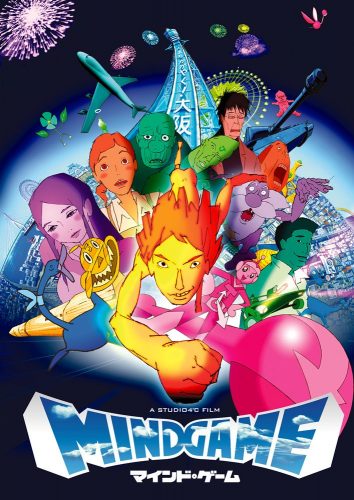
Masaaki Yuasa is the Director, Scriptwriter, and Character Designer for Mind Game, a movie with playful animation and a surreal story. Taking place in multiple time periods, locations, and perspectives, Mind Game utilizes 16 Key Animators to convey its otherworldly nature. For comparison, in the other works I’ve reviewed, Liz and the Blue Bird had 1, A Silent Voice had 8, and 5 Centimeters Per Second had 7.
In this article, I will discuss aspects of how its animation lends to its story, how the story uses visual associations to create a surreal experience, and how the aspect of time makes dreams into a reality.
A Beautiful Display of Skill: The Many Animators of Mind Game
Initially, the film’s visual style can seem disorienting. However, once viewers become accustomed to it, this collage of animation becomes an asset, a ticket into how many minds interpret an ethereal experience.
By combining different thoughts, Mind Game becomes a community of ideas. While it's understandable that one vision, one person at control, can make a work more consistent and effective; there is a benefit to having “too many cooks in the kitchen.”
The phrase refers to the idea that too many people doing the same thing ruins the result. Similarly, it can also mean if too many people are leading others, results will not yield. From a creative standpoint, too many people interpreting a work can make for a disorienting experience.
If the goal, however, is to make something “disconnected,” then having multiple people is efficient. The job of the Director then is not so much to prevent these ideas but to let one’s creative mind roam, then to make sense of it—to create a free association.
Visual Associations: Making Sense of the Surreal
Mind Game uses a lot of visual cues to aid viewers. Characters, for example, will have visual traits. Such as Atsu, a yakuza handyman, who has a head shaped like a pointy egg. Through his preoccupation with a soccer ball, viewers become aware of his background in the sport.
However, given his current “occupation,” (loan shark and killer) it’s difficult to associate Atsu with anything other than a villain. When the yakuza’s boss explains Atsu’s past—how he never knew love, how he’s made mistakes, and how he’s kinder than he looks—it seems impossible to believe, especially after he’s killed the protagonist.
However, those words leave a thread we later follow, an association. With that association comes the film’s next segment. As the yakuza chase the “born again protagonist” and heroines, our heroes crash their car into the sea and are promptly swallowed by a whale. Something so convenient feels like a miracle, a callback to God’s words, “I’m on your side,” when he lets the protagonist revive. It is here, in the whale’s stomach, that a large portion of the film takes place.
Inside the whale’s stomach, the main cast meets an old man. Trapped for 30 years, he recounts his past, a vague “business deal.” A package he delivers gets him chased into the sea. From the visuals, the film implies he’s a former yakuza. Ironically, by escaping the yakuza, they are now closer than before.
From the old man’s story, the film reconnects with prior images and ideas. The briefcase the old man takes has the icon of a manga character, a boy who controls time. Secondly, this character often fights crime, specifically against gangsters.
By taking these two images, the film has connected to a prior association—that even though he is a former yakuza, he isn’t a bad guy, a point that gets reiterated through empathy. This reminds viewers of Atsu’s previous description. The characters in the whale aren’t just in the same position physically but also morally. They all share the same predicament, stuck in a “prison.”
Prior to this part, the film has moved locations several times from Paris to Post-occupied Japan (WW II), finally ending in modern Japan. However, now that the characters are stuck in a whale’s stomach, moving locations is exactly the problem. Thus, to capture the film’s adventurous spirit, each character plays with their imagination, giving them freedom from reality and boredom.
It is here that the film becomes more dream-like. To escape reality, characters play upon their fantasies, making stories and finding adventures where it seemed absent. This requires the audience to connect with loose associations, and in doing so, participate in the same dream state the characters share.
Flashbacks and Time: Reconnecting Dreams to Reality
However, dreams can’t last forever, and the main cast is desperate to find an escape. When an opportunity presents itself, they rush to leave the whale’s mouth. When this happens, all the years spent “captive” disappear. In its place are dreams of the future—the infinite possibilities that come with freedom.
After these future visions, the film has a series of flashbacks. From these scenes, familiar characters can be picked out, allowing viewers to make sense of each character’s past. Through these series of flashbacks, what was once an anachronistic film slowly makes sense. The flashbacks from the beginning of the film now make sense and time flows forward.
Cutting back to the present, we see the old man’s belt, and it’s a rewinding clock. All the years lost in the whale have been changed, and each character now lives their dreams—this time, in reality. Time has allowed everyone to connect to one another, bringing out their best selves and greatest happiness.
Final Thoughts

Mind Game is an interesting experience, one that stands as proof of many minds working together. While confusing at first, Mind Game asks the viewers to release their logic, and follow the movie through visual associations. By doing so, the beauty of its aesthetics make more sense, giving a wonderful example of Japanese animation.


